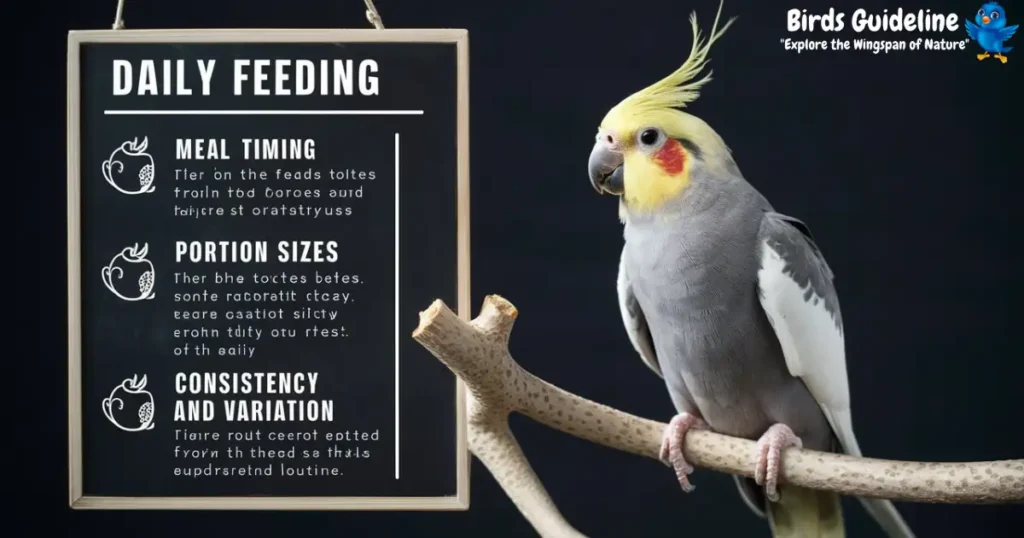The ideal bar spacing for a cockatiel cage is between 1/2 inch to 5/8 inch. This guarantees safety and comfort for your bird.
Selecting the right cage for your cockatiel is crucial for its well-being. A cage with appropriate bar spacing prevents your bird from attempting to escape or getting its head stuck, which could lead to injuries. Cockatiels are playful and curious birds; therefore, their environment should be both secure and engaging.
The dimensions of the cage, along with the bar spacing, play a significant role in providing a safe habitat. It’s important to balance the need for your cockatiel to roam and the necessity of keeping it protected. By choosing a cage with the recommended bar spacing, you’re taking a vital step towards promoting your cockatiel’s health and happiness.
Importance Of Bar Spacing
Choosing the right cage for a cockatiel is crucial for its health and happiness. Among different factors, bar spacing is a key element that deserves special attention. This is because the wrong bar spacing can lead to injury or escape. A cockatiel’s cage should provide safety, prevent escapes, and allow for easy movement and interaction. Understanding the importance of bar spacing helps create a secure and enjoyable environment for these feathered friends.
Ideal Bar Spacing For Cockatiel Safety
For cockatiels, bar spacing is not just a matter of aesthetics; it’s about safety. The ideal gap between bars should be no more than 5/8 inches. This prevents heads or wings from getting stuck, which can cause panic and injury. Proper bar spacing also deters cockatiels from attempting to squeeze through, which can lead to escape or worse, strangulation.
Enhancing Your Cockatiel’s Comfort And Activity
Comfort and activity levels are directly affected by bar spacing. A cage with the correct spacing allows cockatiels to climb and play without slipping or getting their feet caught. It promotes exercise and mental stimulation, which are essential for a cockatiel’s well-being.
Preventing Escape And Maintaining Security
A secure cage is imperative for any pet bird. Bar spacing that’s too wide offers a cockatiel the chance to escape, which can be dangerous for an indoor bird. Owners can rest easy knowing their pet is secure with bars spaced appropriately, reducing the risk of losing their beloved bird.
Considerations For Juvenile Cockatiels
For juvenile cockatiels, bar spacing requires extra thought. Young birds are smaller and more curious, making them more prone to accidents. A cage designed for adults may not be suitable for chicks. Thus, owners should opt for cages with narrower bar spacing to accommodate the size and safety needs of younger birds.
Bar Spacing And Cage Longevity
Finally, bar spacing can influence the longevity of a cockatiel cage. Correct spacing helps the structure withstands the bird’s beak and claw activities. Cages with durable construction and proper bar spacing are more likely to last longer, providing a safe home for cockatiels throughout their lives.
Ideal Bar Spacing
Finding the right bar spacing for a cockatiel cage is crucial. It makes sure your bird stays safe and comfortable. The ideal bar spacing prevents them from escaping or getting stuck. Let’s dive into what makes the perfect fit for your feathered friend.
Ideal Bar Spacing For Cockatiels
Cockatiels need bars spaced just right. Between 1/2 inch to 5/8 inch is perfect. This spacing stops them from squeezing through or trapping their heads. Always measure the spacing before buying a cage.
Why Is This Spacing Important?
- Prevents escape: Proper spacing keeps your cockatiel safely inside.
- Avoids injuries: Too wide and they might get stuck; too narrow and they can’t move around properly.
- Maintains comfort: Gives them enough room to move and play without risk.
Choosing The Right Cage
Select a cage with the correct bar spacing and also consider:
- Size: Bigger is always better. More space to fly and play.
- Shape: Rectangular cages are best. They offer more usable space.
- Accessories: Look for cages with feeders, perches, and toys.
Quick Tips For Cage Setup
- Position: Place the cage in a quiet, bright area away from drafts.
- Perches: Offer different perch sizes to keep their feet healthy.
- Cleaning: Regular cleaning prevents diseases. Choose a cage easy to clean.
Bar Material Choices
Choosing the right bar spacing and material for a cockatiel cage is crucial for the safety and comfort of your feathered friend. The material must be durable, non-toxic, and designed to withstand a cockatiel’s active lifestyle. Let’s look at the options that help your pet thrives in their home environment.
Stainless Steel: A Hygienic Choice
Stainless steel stands out as a top choice for bird cage construction. Its non-porous surface makes it easy to clean, preventing the buildup of harmful bacteria. This material resists rust and corrosion, providing a long-lasting habitat for your cockatiel.
Powder-coated Wires: Colorful And Safe
Powder-coated wires offer a colorful touch to your pet’s home. They’re coated with a safe, non-toxic paint that adds a layer of protection against rust. It’s essential to check for any chips or wear in the coating regularly to maintain a safe environment for your bird.
Wrought Iron: Sturdy And Elegant
Wrought iron cages provide a sturdy framework that can handle the playful antics of cockatiels. This material presents an elegant appearance, but it requires a protective finish to prevent rust. Regular upkeep will keep a wrought iron cage in excellent condition.
Cold Rolled Steel: Durable And Budget-friendly
For a balance between durability and cost, cold rolled steel is a practical option. It’s stronger than regular steel and more affordable than stainless steel. Make sure the surface is properly treated to prevent rust and protect your bird’s health.
Common Mistakes
Choosing the right cage for your cockatiel is crucial for its safety and well-being. One key aspect to consider is bar spacing. Many bird owners make common mistakes when selecting a cage, not realizing the impact on their feathered friend. Let’s look at these common errors to help you provide the best home for your cockatiel.
Incorrect Bar Spacing
Cockatiels need specific bar spacing to prevent escape and injury. Bars spaced more than 5/8 inch apart allow cockatiels to squeeze through or get their head stuck. On the other hand, bars too close together can restrict movement and cause frustration.
Choosing Style Over Function
Some cages prioritize aesthetics over practicality. A beautiful cage with improper bar spacing is dangerous. Always choose a cage with the right bar spacing over a stylish but unsafe option.
Ignoring Horizontal Bars
Cockatiels are climbers and enjoy cages with horizontal bars. A common mistake is choosing a cage with only vertical bars, limiting their ability to climb and exercise. Make sure your cage includes both vertical and horizontal bars for your pet’s stimulation.
Not Considering Cage Shape
The shape of the cage also affects bar spacing. Circular cages may have uneven spacing and create gaps. Choose a rectangular cage to maintain consistent bar spacing and a safer environment for your cockatiel.
Overlooking The Door Design
The cage door is part of the overall bar spacing consideration. Doors with large gaps or poor latches can be an escape risk. Select cages with secure doors that match the recommended bar spacing to keep your cockatiel safe.
Cage Types And Bar Spacing
Choosing the right cage for a cockatiel is crucial for its health and happiness. The perfect cage type and bar spacing are key factors to consider. A cage should provide ample space for movement and the correct bar spacing to guarantee safety. Let’s look at the different cage types and the ideal bar spacing for cockatiels.
Exploring Cage Types For Cockatiels
Cockatiels thrive in cages that are spacious and comfortable. There are several types of cages to consider:
- Standard Cages – Usually rectangular, offering good space and easy placement.
- Flight Cages – Larger, allowing for ample flying room.
- Aviaries – The most spacious option, suitable for multiple birds.
- Travel Cages – Smaller, portable, for short-term use.
All these types come with varying bar spacing, which is essential to cockatiel safety.
Ideal Bar Spacing For Cockatiel Cages
Bar spacing is critical to prevent escape or injury. For cockatiels, the ideal spacing is:
| Cage Type | Bar Spacing |
|---|---|
| Standard Cage | 1/2″ to 5/8″ |
| Flight Cage | 1/2″ to 5/8″ |
| Aviary | 1/2″ to 3/4″ |
| Travel Cage | 1/2″ to 5/8″ |
This range makes sure the bird cannot squeeze through the bars or get its head stuck. Always measure the bar spacing before purchasing a cage for your cockatiel.
Choosing The Right Bar Spacing
Safety comes first when selecting a cage. A cage with incorrect bar spacing can lead to injuries or escapes. Here are quick tips to choose the right bar spacing:
- Measure the bar spacing with a ruler or tape measure.
- Make sure it falls within the recommended range of 1/2″ to 5/8″.
- Opt for horizontal bars that offer better climbing opportunities.
Right bar spacing paired with a suitable cage type makes a happy home for your feathered friend.
Monitoring Your Cockatiel
Understanding the right bar spacing for a cockatiel cage is crucial to guarantee the safety and comfort of your feathered friend. Proper monitoring of your cockatiel also plays a significant role in its well-being. It involves observing their behavior, making sure they have ample space to move, and preventing any potential hazards that could arise from incorrect cage specifications.
Importance Of Correct Bar Spacing
Choosing the right bar spacing for your cockatiel’s cage is vital. The ideal measurement is between 1/2 inch to 5/8 inch. This prevents your bird from attempting to squeeze through or getting stuck, which could lead to injuries. Consistent checks guarantee that the space remains safe and secure for your pet.
Regular Observation Routines
Setting up a routine to monitor your cockatiel helps in identifying any changes in behavior or health. Look for signs like active movement, playful interactions, and a steady appetite. These indicators reflect a happy and healthy bird. Conversely, lack of activity or changes in eating habits can signal issues needing immediate attention.
Interaction And Engagement Checks
Engage with your cockatiel regularly to guarantee it remains social and stimulated. Birds are intelligent creatures that require mental stimulation to stay content. Use toys and spend quality time together to keep your cockatiel’s mind sharp and spirits high.
Safety Measures And Precautions
- Inspect the cage regularly for any damage or sharp edges.
- Make sure all doors and openings are secure to prevent escape.
- Keep the cage away from other pets, harsh sunlight, and draughts.
By following these steps, you create a safe and nurturing environment for your cockatiel, promoting its overall health and longevity.
Frequently Asked Questions
The ideal bar spacing for a cockatiel cage is between 1/2 inch and 5/8 inch. This size prevents escape and promotes safety.
Bar spacing in bird cages refers to the distance between the bars, crucial for preventing escape and maintaining safety. Optimal spacing varies based on bird size, with smaller birds requiring narrower gaps.
To measure bar spacing, use a ruler or tape measure. Start from the center of one bar, extending to the center of the adjacent bar. Confirm accuracy by checking multiple sections. This method provides a precise measurement of the space between bars.
Conclusion
Selecting the right bar spacing for your cockatiel’s cage is crucial. A gap of 1/2 to 5/8 inches guarantees safety and comfort. Remember, a happy bird is a healthy bird. With the ideal spacing, your cockatiel can thrive, offering you endless joy and companionship.
Choose wisely for your feathered friend’s home!


